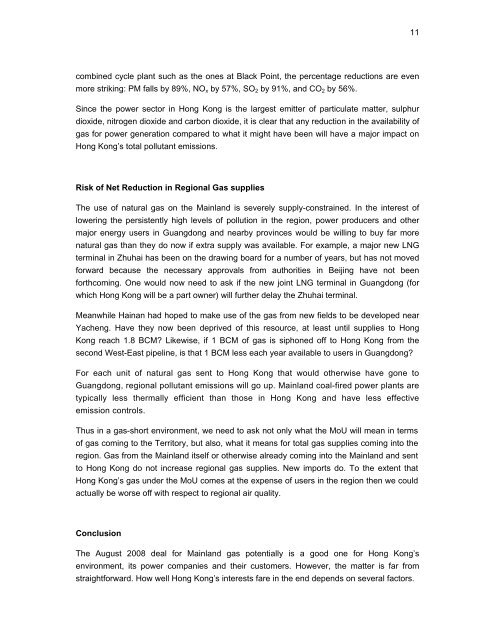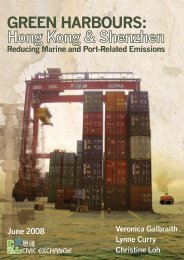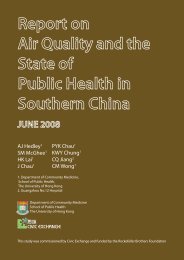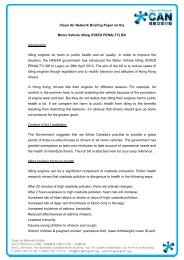Create successful ePaper yourself
Turn your PDF publications into a flip-book with our unique Google optimized e-Paper software.
11<br />
combined cycle plant such as the ones at Black Point, the percentage reductions are even<br />
more striking: PM falls by 89%, NO x by 57%, SO 2 by 91%, and CO 2 by 56%.<br />
Since the power sector in <strong>Hong</strong> Kong is the largest emitter of particulate matter, sulphur<br />
dioxide, nitrogen dioxide and carbon dioxide, it is clear that any reduction in the availability of<br />
gas for power generation compared to what it might have been will have a major impact on<br />
<strong>Hong</strong> Kong’s total pollutant emissions.<br />
Risk of Net Reduction in Regional Gas supplies<br />
The use of natural gas on the Mainland is severely supply-constrained. In the interest of<br />
lowering the persistently high levels of pollution in the region, power producers and other<br />
major energy users in Guangdong and nearby provinces would be willing to buy far more<br />
natural gas than they do now if extra supply was available. For example, a major new LNG<br />
terminal in Zhuhai has been on the drawing board for a number of years, but has not moved<br />
forward because the necessary approvals from authorities in Beijing have not been<br />
forthcoming. One would now need to ask if the new joint LNG terminal in Guangdong (for<br />
which <strong>Hong</strong> Kong will be a part owner) will further delay the Zhuhai terminal.<br />
Meanwhile Hainan had hoped to make use of the gas from new fields to be developed near<br />
Yacheng. Have they now been deprived of this resource, at least until supplies to <strong>Hong</strong><br />
Kong reach 1.8 BCM? Likewise, if 1 BCM of gas is siphoned off to <strong>Hong</strong> Kong from the<br />
second West-East pipeline, is that 1 BCM less each year available to users in Guangdong?<br />
For each unit of natural gas sent to <strong>Hong</strong> Kong that would otherwise have gone to<br />
Guangdong, regional pollutant emissions will go up. Mainland coal-fired power plants are<br />
typically less thermally efficient than those in <strong>Hong</strong> Kong and have less effective<br />
emission controls.<br />
Thus in a gas-short environment, we need to ask not only what the MoU will mean in terms<br />
of gas coming to the Territory, but also, what it means for total gas supplies coming into the<br />
region. Gas from the Mainland itself or otherwise already coming into the Mainland and sent<br />
to <strong>Hong</strong> Kong do not increase regional gas supplies. New imports do. To the extent that<br />
<strong>Hong</strong> Kong’s gas under the MoU comes at the expense of users in the region then we could<br />
actually be worse off with respect to regional air quality.<br />
Conclusion<br />
The August 2008 deal for Mainland gas potentially is a good one for <strong>Hong</strong> Kong’s<br />
environment, its power companies and their customers. However, the matter is far from<br />
straightforward. How well <strong>Hong</strong> Kong’s interests fare in the end depends on several factors.








